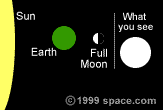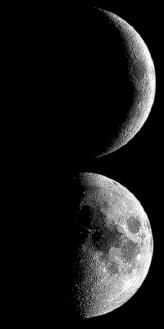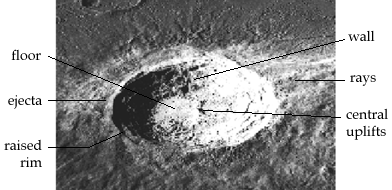Surface Features on the Moon
 We always see the same side of the moon. The moon and Earth are tidally-locked
in this position. In a few more billion years, the same face of the Earth will
always face the moon. The moon will never rise or set from one point on the
Earth. Will future astronomy students still have to learn about its phases?
We always see the same side of the moon. The moon and Earth are tidally-locked
in this position. In a few more billion years, the same face of the Earth will
always face the moon. The moon will never rise or set from one point on the
Earth. Will future astronomy students still have to learn about its phases?
 Terminator and Limb
Terminator and Limb
The dividing line between day and night on the moon is called
the terminator. The strong shadows mark the best place
to observe craters, mountains and other surface features (see here).
The moon has innumerable craters, some incredibly large. Very large dark patches are seen on it's surface, called maria, after the Latin word for sea. There is no water on the Moon. Instead, the mare are smooth, low-lying surface regions, filled with ancient lava flows.
A Dead Moon
While the maria suggest active volcanism, they formed billions of years ago,
though late enough to escape heavy bombardment (and show few craters).
Sometimes the maria are seen to fill in older craters.
We can use the density of craters seen on a surface to give us an
estimate of the age of that surface, if we know the rate of cratering
with time. Such cratering studies reveal absolute ages of
the moon surfaces, which can be checked using radio-active
dating of moon rocks brought back by the astronauts.
Sinuous rilles, channels seen to cut or channelled into the smooth
freshly formed maria, were formed from volcanic flows long ago.
Today, the Moon is entirely cold, dry and lifeless.
|
Craters on the Moon Meteorite speeds are 15-60 km/s, about 20x the speed of a bullet. Even small meteorites will create an enormous crater!Where the meteorite hits, the pressure and temperature reaches very high values, completely vaporizing the meteorite, leaving only the crater. The shock wave generated blasts away ejecta, seen as rays stretching outside of the crater, possibly creating a secondary crater. The crater walls are usually raised a bit in a stiff rim. Inner rings of mountains are sometimes seen along the inside walls. At the center of the crater floor, one sometimes sees a central peak or uplift. Below the crater the rock is severely fractured by the impact. |
  
|